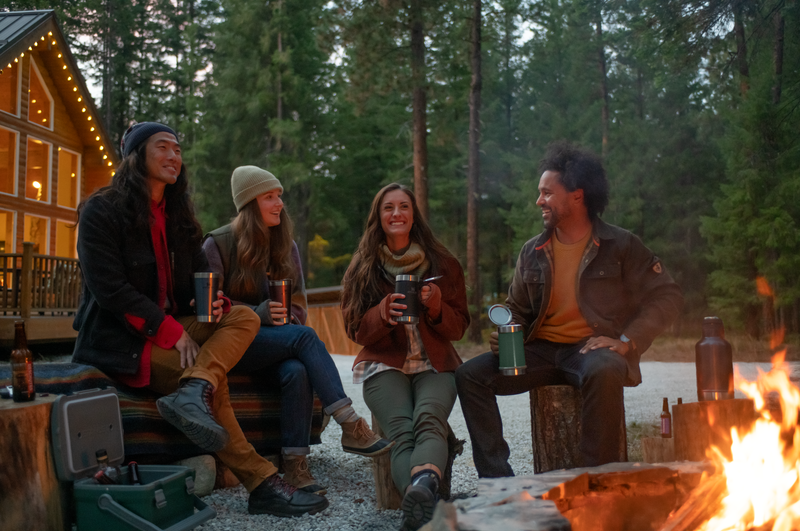- Improving short-term memory;
- Reducing stress;
- Increasing vitamin D levels;
- Improving sleep;
- Strengthening the immune system;
- Increasing happiness;
- Improving vision;
- Inspiring creativity;
- Restoring mental health.
While there are many pros to being outdoors, recreational activities can also pose a threat to the environment and frequent recreational adventurers. Whether you are camping, hiking, or visiting a park, it is crucial to maintain certain best practices to help ensure the safety of you, your family, other outdoorsmen, and the integrity of the environment.
1. Plan Ahead
To make the most of your outdoor time, it’s important to plan before leaving for your destination. Preparing for different scenarios can help you and your family have a successful outing while staying safe. Before leaving for your destination, consider the following preparation best practices:
- Check the accessibility of your destination. This includes looking up the hours of operations to ensure the trail or campground is open, as well as directions if you are planning to take more than one car.
- Look at the weather in advance. Different weather patterns may cause trails or campgrounds to become impassable. Knowing the weather beforehand can help you be prepared for any type of scenario.
- Get advice from experienced outdoorsmen. If you are going to a destination for the first time, it can be helpful to get advice from people who have already been there. This advice can include which campgrounds to go to, activities to participate in, and safety precautions.
- Go during the safest time of day. If you are participating in outdoor activities for the first time and have never been to the destination, it’s important to go during a safe time of the day. Make sure you have enough daylight to see where you are going and to ensure you won’t get stuck in an unknown location at nighttime.
2. Communicate
Many hikers, campers, and other outdoor enthusiasts may find themselves lost during an excursion. This situation can become instantly overwhelming and may push back your expected arrival time. Outdoor recreation can come with risks, and it’s important to let friends and family know your plans in case something happens. Consider telling a few friends and family this pertinent information:
- A basic timeframe of your arrival;
- An itinerary with numbers you can be reached at;
- Phone numbers of the people you are going to be with;
- Updates to your location when you have cell service;
- Specific trails and campgrounds that you will be using.
By sharing this information with friends and family, they will be able to alert authorities faster in worst-case scenarios.
3. Bring the Right Gear
Bringing the right equipment or gear can help ensure you have a successful outdoor adventure. Many outdoor activities need special gear. Additionally, you should take weather and climate into consideration so you can stay comfortable. For instance, hikers will need the following gear:
- Backpack;
- Hiking boots or shoes;
- Moisture-wicking pants and jacket;
- Food and water;
- Navigation tools;
- First-aid kit;
- Extra clothes;
- A knife.
Additionally, campers will need the following gear:
- Tent;
- Sleeping bags, pads, and pillows;
- Headlamps and flashlights;
- Camping chairs and tables;
- Camping cutlery, plates, and mugs;
- Lanterns;
- Firewood;
- Cooler with drinks and food;
- Trash bags.
While this is not an exhaustive list, it is a good starting point. It is also important to consider buying durable gear that lasts since you are likely to use it again and don’t want to buy new items every year.
4. Don’t Go Alone
While many people enjoy camping or hiking alone, it can be overwhelming for outdoor beginners. Some dangers of camping or hiking alone include:
- Medical emergencies;
- Getting lost;
- Encountering predators;
- Being unfamiliar with your surroundings;
- Encountering strangers that make you uncomfortable;
- Forgetting essential gear;
- Overestimating your abilities.
Bringing a friend or two with you when you camp or hike can be helpful if you encounter any of the above problems. Additionally, bringing experienced campers or hikers can help you learn the essential skills you need to successfully do these activities alone.
Even if you can’t bring another human with you, you might still enjoy camping with your dog.
5. Practice Leave No Trace
Leave No Trace is a set of seven principles that helps outdoor enthusiasts maintain the integrity of the outdoors. While Leave No Trace was created to maintain backcountry areas, it has adapted to fit a variety of outdoor settings and recreational activities. The seven principles are as follows:
- Plan Ahead and Prepare: Poor planning can lead to damage to natural resources. By planning, outdoor adventurists can minimize their impact on the land while staying safe.
- Travel and Camp on Durable Surfaces: Campers and hikers must stick to trails and campgrounds to lessen the risk of soil erosions and undesirable trails.
- Dispose of Waste Properly: Outdoor enthusiasts should be cognizant of the impact of the waste left in the wilderness. This includes proper disposal of human waste, trash, spilled foods, cigarette butts, plastic, and fishing line.
- Leave What You Find: This principle minimizes site alterations and avoids damaging live trees and plants. Additionally, campers and hikers should leave cultural objects where they stand on public lands.
- Minimize Campfire Impacts: Campfires can degrade the natural appearance of many areas due to smoke and the increasing demand for firewood. Use existing fire rings or bring your firewood to help maintain the natural appearance of camp areas.
- Respect Wildlife: Wildlife and plants should not be disturbed. Campers and hikers should travel quietly to avoid stressing the animals. Never touch, feed, or get close to wild animals.
- Be Considerate of Other Visitors: Maintaining courtesy toward other outdoor enthusiasts can ensure that everyone enjoys the outdoor experience. Excessive noise, uncontrolled pets, and damaged areas can lessen other people’s experiences.
6. Stay in Designated Areas
Camping or hiking in designated areas can help lessen the impact you have on the outdoors. According to the Leave No Trace travel principle, the goal of outdoor travel is to move through natural areas while avoiding damage to land and waterways.
Hikers should try to stay on constructed trails to avoid making multiple routes that scar the landscape. Additionally, these trails have already been vetted for safety. If there are no constructed trails, hikers must be considerate of the surface durability, vegetation, and the size of the hiking group. Stick to rock, sand, or gravel surfaces, and try to limit trampling on vegetation.
Campers generally have two options when it comes to choosing campsites: front-country camping or backcountry camping. Frontcountry refers to campgrounds that have designated camping spots. These spots consist of a firepit, a parking space for car camping, a picnic table, and sometimes take a reservation to hold them. These spots can help campers limit their impact on the environment by setting up the boundaries of their campsite.
Backcountry campsites are typically first-come, first-serve. Campers should look for flat, durable ground that can withstand a lot of walking and storage. Avoid camping on fragile vegetation, like flowers or grass, and do not set up tents near water.
7. Leave Wildlife Alone
While seeing animals in the wild can be inspiring, it is best to leave them alone. Loud noises and quick movements can cause the animal stress and affect its ability to live in rigorous environments. If the animal becomes dependent on campers feeding it, it could lose its ability to hunt or forage.
It is also important not to feed or touch the animal to avoid potentially transferring diseases like rabies. Additionally, if animals feel trapped or cornered, they could attack by biting, scratching, or pecking. Dealing with a medical emergency in the wilderness can be stressful and overwhelming. If you see an animal that is hurt or sick, leave it be and notify a park ranger as soon as possible.
8. Hydrate
Campers and hikers may engage in physical activity during the warm-weather season, which can easily lead to dehydration. Signs of dehydration include:
- Feeling very thirsty;
- Dry mouth;
- Urinating and sweating less than usual;
- Dark-colored urine;
- Dry skin;
- Fatigue;
- Dizziness.
To combat these symptoms while outdoors, consider these tips to help keep you hydrated:
- Use insulated bottles to keep water cold;
- Drink often rather than chugging a lot of water at once;
- Replace electrolytes if you sweat a lot;
- Drink more water at higher altitudes;
- Hydrate before you go on hikes;
- Wear sunscreen to avoid sunburns, which can speed up dehydration.
9. Bring a First Aid Kit
Although campers and hikers may not expect to get hurt, it’s important to bring a first aid kit just in case. However, first aid kits for the outdoors may look different than typical first aid kits you see at home or in school. For instance, because you have limited space, outdoor first aid kits generally only have the bare essentials. It should carry items that will address common outdoor maladies and pertain to your health situation. A common outdoor first aid kit should include the following:
- Prescription medication labeled in a bag;
- Single-use packs of ibuprofen, Imodium, and an antihistamine;
- Moleskin or athletic tape;
- Bandages in multiple sizes;
- Sterile gauze;
- Latex gloves;
- Sanitizer;
- Tweezers;
- A small knife or scissors;
- Antiseptic ointment.
10. Be Mindful of Your Group
If you are camping or hiking with a large group, it’s important to be mindful of everyone’s comfort level and abilities. For instance, if you are including new campers, it may be difficult for them to camp in the backcountry for the first time. Additionally, inexperienced hikers may find ten-mile hikes uncomfortable and dissatisfying. For everyone to enjoy the outdoors safely, get the group’s perspective on what is and is not attainable for your outdoor adventure. Lastly, assign roles for people so that no one person is left doing all the work. For example, someone can be in charge of cleaning up the campsite while another is in charge of cooking food. This way, everyone will get to contribute to the excursion.
Outdoor adventures can be fun, however, there are some risks associated with them. By adhering to the safety tips above, you can ensure that your outdoor recreation adventure is safe and successful.
Back to HOW-TO GUIDES




